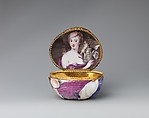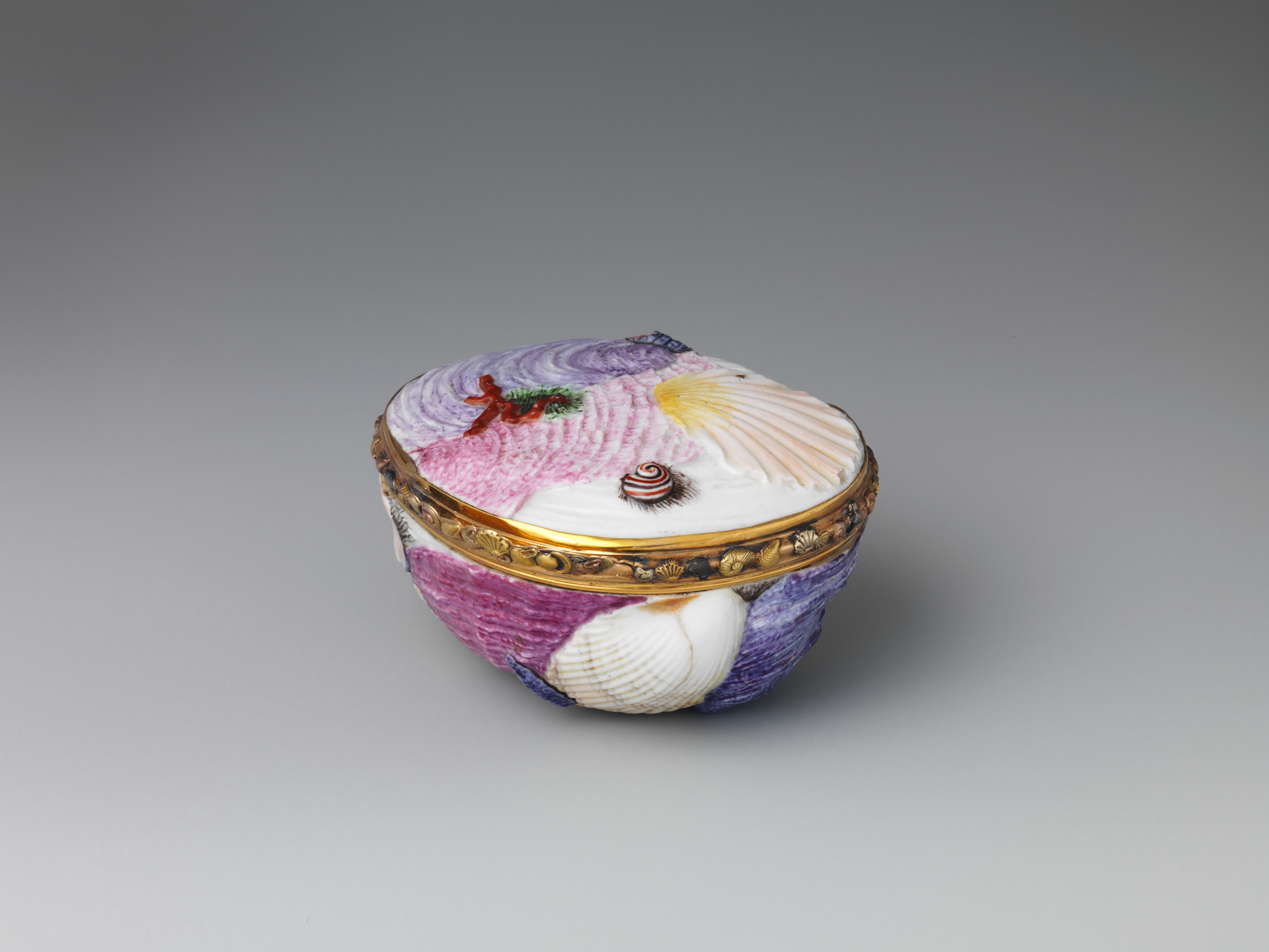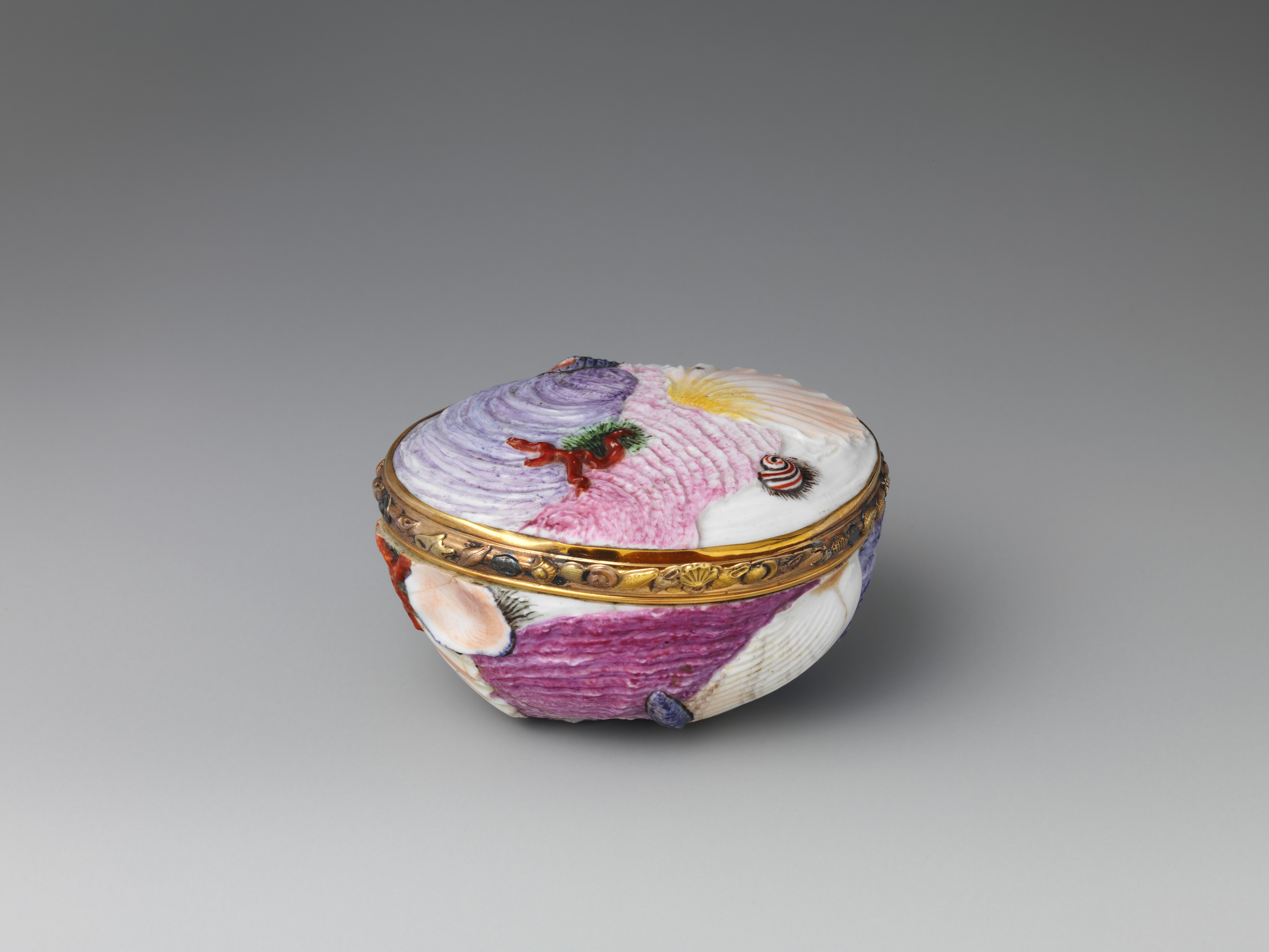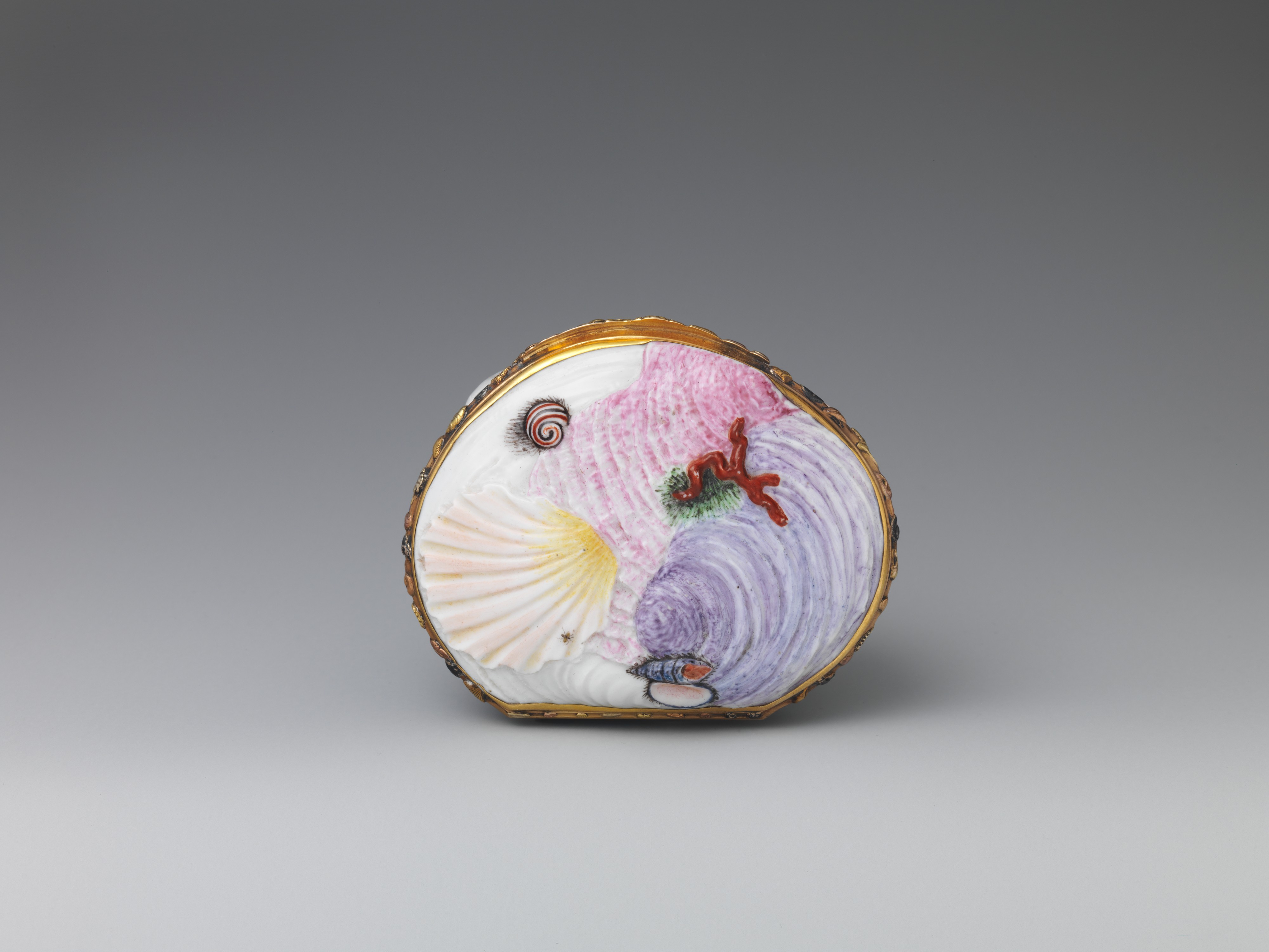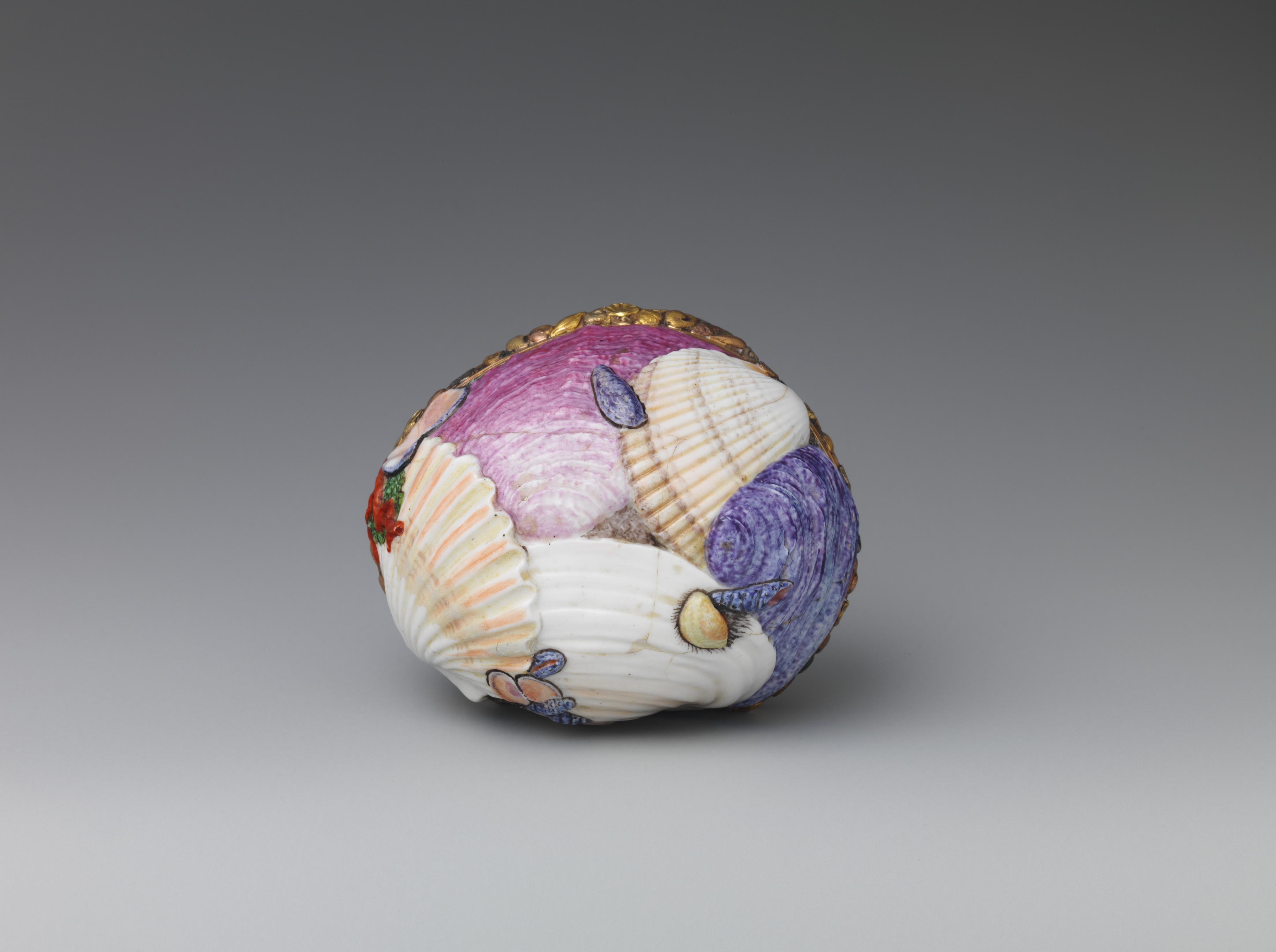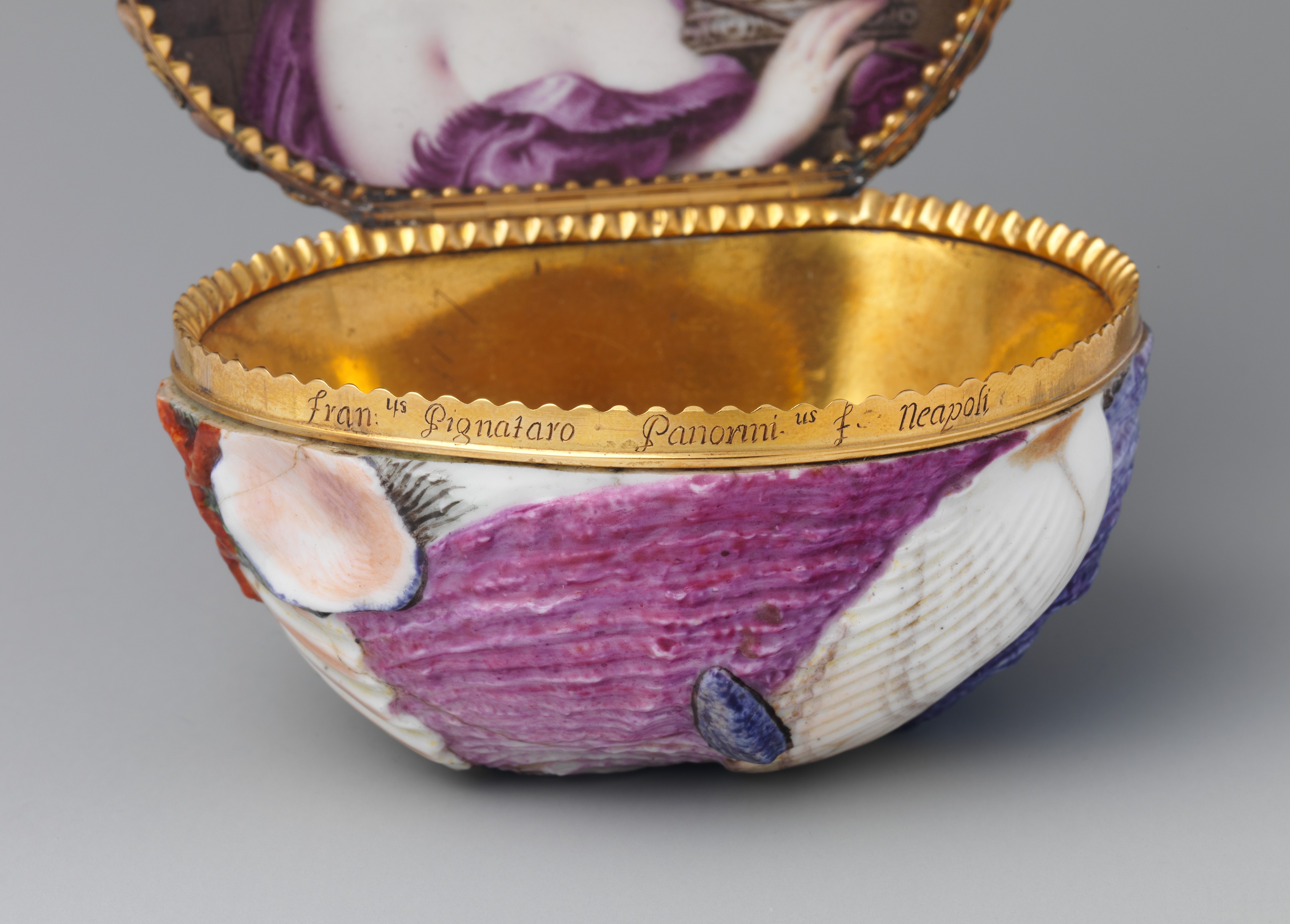Snuffbox
Not on view
The Capodimonte factory in Naples produced a variety of forms of snuffboxes,[1] presumably in recognition of both the widespread popularity of snuff taking and the demand for boxes made of materials less expensive than gold. While gold boxes were considered the most desirable of containers made to transport snuff, the popularity of porcelain made it a fashionable medium for boxes despite its lack of intrinsic value. In addition, porcelain’s ability to be both modeled in low relief and painted in polychrome enamels offered a range of decorative possibilities that exceeded those available to goldsmiths.
Capodimonte factory records indicate that this model of snuffbox, formed as if from a series of overlapping shells, was first produced in December 1743.[2] The large, overlapping shell motifs that compose the box are encrusted with tiny shells and pieces of coral, also in porcelain, and the use of low relief for all of these motifs enhances their realism. The exaggerated organic quality of this design was unprecedented in European porcelain during this time, and it is one of the most innovative models produced at Capodimonte, a factory distinguished by the originality of its production. The most elaborate and ambitious works made at the factory in this stylistic genre are an ewer and basin, now in the collection of the Art Institute of Chicago,[3] and a basin from a different model now in the Museo di Capodimonte, Naples.[4] Each of these objects appears to have been formed by shell and other marine motifs, which are so skillfully realized that the intended function is clearly secondary to the object’s evocation of the natural world through the medium of porcelain. No other eighteenth-century European porcelain factory produced works in a comparably organic style, and the snuffboxes, ewer, and basins reflect the unsurpassed originality and creativity of Giuseppe Gricci (Italian, ca. 1700–1770), the head modeler at the factory. Factory records credit Gricci with the creation of the Capodimonte snuffbox model,[5] and consequently, the larger objects produced at this time are also attributed to him on the basis of their similarity in concept to the snuffbox design.
Both the Museum’s snuffbox and the Chicago ewer and basin have polychrome decoration that heightens the realism of the various marine motifs. Shells are delineated in a variety of colors, textures are emphasized through subtle shading, and the surfaces are enlivened by the painted marine vegetation that appears attached to some of the shells. The choice of enamel colors for the snuffbox was not driven by concern for fidelity to nature, although the painting was executed with considerable detail and delicacy. Interestingly, the vigor and realism of Gricci’s modeling are not dependent on the enamel decoration, as evidenced by another snuffbox from the same model in the Metropolitan’s collection (1982.60.338), and by the basin now at the Museo di Capodimonte,[6] both of which have been glazed but not polychromed. In both instances, the modeling is so successful that the individual components are easily discerned, and the composition is fully legible without the distinctions created by the application of enamel colors.
The interior covers of the known snuffboxes of this model are decorated with enameled compositions that vary widely in their subject matter. On this example, a turbaned woman holding a mahl stick or brush looks out at the viewer. In her left hand she holds both a Mannerist tankard that appears to be made of silver and a crumpled sheet of diagrams. In the back, a book and a brazier rest on a stone wall. It is possible that the figure is intended to be a personification of the arts with the objects that accompany her representing painting, sculpture, design, and literature. Figures representing an allegory of the arts were sometimes depicted with masks to symbolize illusion;[7] in this instance, the box made of shells provided the sense of illusion that served as a complement to the personification of the arts depicted inside.[8]
It is very likely that the artist who painted this scene was also responsible for the interior of the cover of the second box from this model at the Museum, which depicts a nursing mother with three children. Both scenes employ an extremely delicate stippled technique, and the contours of the faces, the treatment of the hair, and the rendering of the drapery are handled in a very similar manner. A factory document dated 1743 records Giovanni Caselli (Italian, 1698–1752) gilding two snuffboxes “with small seashells on the cover.”[9] The indication that Caselli decorated boxes from this model, coupled with the quality of the painting, makes an attribution to Caselli for both boxes plausible, and indeed, Caselli’s name has been suggested for two boxes from the same model in the Victoria and Albert Museum, London,[10] and a similar box at San Martino, Naples,[11] which have covers painted in very much the same style. While the sources of some of the scenes attributed to Caselli have been identified,[12] most have not, including those on the Museum’s two boxes discussed here, which suggests a wide and varied range of images was made available at the factory for artists to copy.
The gold mounts attaching the cover to the body of the box are unusual in quality and design. A continuous band of tiny shells and sea creatures has been applied to the upper rim, and they are made from a variety of colors, including gold, as well as silver, to enhance the decorative effect and presumably to differentiate them from one another. It is rare to find gold mounts on snuffboxes in which the design of the mounts relates so closely to that of the box itself. The goldsmith appears to have taken pride with his work; fran:us pignataro panormius f. neapoli is engraved on the rim. This inscription informs us that Francesco Pignataro was from Palermo, and he made the mounts in Naples; nothing more is known about this clearly accomplished goldsmith.
Footnotes
(For key to shortened references see bibliography in Munger, European Porcelain in the Metropolitan Museum of Art. NY: The Metropolitan Museum of Art, 2018)
1 See Carola-Perrotti 1986b, pp. 238–50, nos. 180–93 (catalogue entries by Paola Giusti, Silvana Musella Guida, and Angela Carola-Perrotti); Giusti 1986.
2 Alvar Gonzalez-Palacios in Golden Age of Naples 1981, vol. 2, p. 389.
3 Gonzalez-Palacios in ibid., pp. 388–89, no. 135b.
4 Andreina d’Agliano in Pietsch and Witting 2010, p. 92, no. 94.
5 Gonzalez-Palacios in Golden Age of Naples 1981, vol. 2, p. 388.
6 Agliano in Pietsch and Witting 2010, p. 92, no. 94.
7 For example, see Frans van Mieris the Elder (Dutch, 1635–1681), Pictura (An Allegory of Painting), 1661, in the J. Paul Getty Museum, Los Angeles (82.PC.136).
8 I thank Denise Allen, Curator, Department of European Sculpture and Decorative Arts, The Metropolitan Museum of Art, New York, for sharing her thoughts regarding this snuffbox and bringing the van Mieris painting at the Getty to my attention.
9 Maia Confalone in Sovrane fragilità 2007, p. 115.
10 C.53-1968 (Mottola Molfino 1976–77, vol. 2, pl. ix) and C.110-1945.
11 Agliano in Pietsch and Witting 2010, p. 97, no. 105.
12 Confalone in Ritorno al Barocco 2009, vol. 2, p. 209, no. 4.98.
Due to rights restrictions, this image cannot be enlarged, viewed at full screen, or downloaded.
This artwork is meant to be viewed from right to left. Scroll left to view more.
